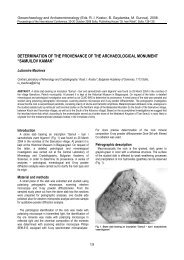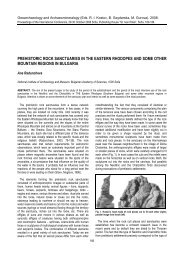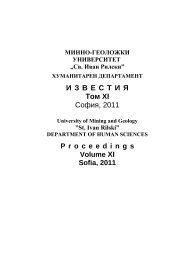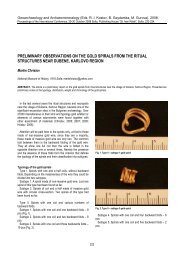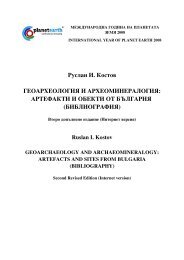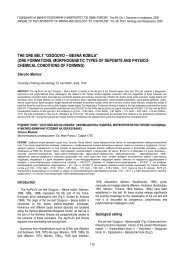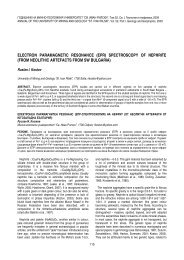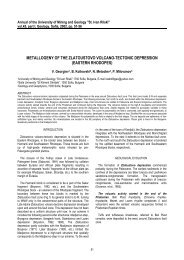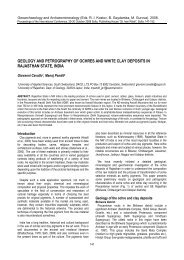Geological Aspect of the Problem Dating the Great Egyptian Sphinx
Geological Aspect of the Problem Dating the Great Egyptian Sphinx
Geological Aspect of the Problem Dating the Great Egyptian Sphinx
You also want an ePaper? Increase the reach of your titles
YUMPU automatically turns print PDFs into web optimized ePapers that Google loves.
All <strong>the</strong> following phases differed by wavy lowering <strong>of</strong> <strong>the</strong> sea<br />
level marks. It is <strong>the</strong> sea level during <strong>the</strong> Calabrian phase<br />
which is <strong>the</strong> closest to <strong>the</strong> present mark with <strong>the</strong> highest GES<br />
hollow at its level. High level <strong>of</strong> sea water also caused <strong>the</strong> Nile<br />
overflowing and created long-living water-bodies. As to time it<br />
corresponds to 800000 years.<br />
After <strong>the</strong> completion <strong>of</strong> lacustrine (fresh water) stage in <strong>the</strong><br />
GES life o<strong>the</strong>r natural processes superimpose <strong>the</strong> vertical GES<br />
pr<strong>of</strong>ile formed by water, especially at <strong>the</strong> stage <strong>of</strong> desert<br />
climate development. The sand abrasion (Eolian in a broad<br />
sense) was directed to smoothing <strong>the</strong> contrast forms and led to<br />
even greater destruction <strong>of</strong> <strong>the</strong> monument.<br />
Fig. 5. The upper hollow <strong>of</strong> <strong>the</strong> <strong>Sphinx</strong> (white arrow)<br />
It follows from <strong>the</strong> investigations <strong>of</strong> <strong>the</strong> substance<br />
composition <strong>of</strong> rocks in geological cross-sections that <strong>the</strong>y<br />
were deposits <strong>of</strong> fresh-water reservoirs, lakes supplied with <strong>the</strong><br />
Nile waters. The Nile ran at a higher level at that time. The<br />
Pleistocene lakes occupied <strong>the</strong> territory <strong>of</strong> <strong>the</strong> present Birket-<br />
Karun Lake at least ten times (Rushdi, 1965, 89). Tools <strong>of</strong><br />
ancient people were found in <strong>the</strong>se lacustrine deposits.<br />
Chumakov (1965; 1967) in his works dedicated to <strong>the</strong><br />
Pliocene and Pleistocene deposits <strong>of</strong> <strong>the</strong> Nile Valley also<br />
comes to a conclusion about <strong>the</strong> broad development <strong>of</strong><br />
lacustrine deposits. He notes that in <strong>the</strong> Late Pliocene <strong>the</strong> sea<br />
waters began penetrating <strong>the</strong> Nile Valley and its level rose.<br />
That led to formation <strong>of</strong> lacustrine deposits which are at <strong>the</strong><br />
mark <strong>of</strong> 180 m above <strong>the</strong> present level <strong>of</strong> <strong>the</strong> Mediterranean<br />
Sea. The lacustrine deposits are also known in <strong>the</strong> Fajum<br />
depression.<br />
In his large generalizing work Tseiner (1963) presents results<br />
from <strong>the</strong> analysis <strong>of</strong> measuring <strong>the</strong> levels <strong>of</strong> <strong>the</strong> coastal<br />
terraces <strong>of</strong> <strong>the</strong> African coast <strong>of</strong> <strong>the</strong> Mediterranean Sea,<br />
regularly distributed in time from <strong>the</strong> Pleistocene to <strong>the</strong><br />
Holocene. Based on <strong>the</strong> obtained data, <strong>the</strong> author has made a<br />
plot with distinguishing certain phases, which corresponded to<br />
absolute marks <strong>of</strong> Sea levels and time intervals (Fig. 6). As is<br />
seen from <strong>the</strong> figure, <strong>the</strong> highest mark <strong>of</strong> <strong>the</strong> Mediterranean<br />
Sea level took place during <strong>the</strong> Calabrian phase and was<br />
above 160 m relative to <strong>the</strong> present sea level.<br />
Fig. 6. Curve <strong>of</strong> <strong>the</strong> ocean level change during <strong>the</strong> Pleistocene from <strong>the</strong><br />
data <strong>of</strong> <strong>the</strong> Mediterranean Sea terraces (Tseiner, 1963). Levels: 1 –<br />
Calabrian, II – Sicilian, III – Milan, IV – Tirranian, V – Monastery.<br />
Conventional signs: along <strong>the</strong> vertical axis – meters; along <strong>the</strong> horizontal<br />
axis – thousands <strong>of</strong> years<br />
The suggested hypo<strong>the</strong>sis concerning <strong>the</strong> relative dating <strong>of</strong><br />
GES erection is based on <strong>the</strong> analogy with natural processes<br />
known in marine geology and explains <strong>the</strong> formation <strong>of</strong> hollows<br />
in <strong>the</strong> <strong>Sphinx</strong> as wave-cut ones. Fur<strong>the</strong>r necessity <strong>of</strong> studying<br />
<strong>the</strong> substance composition <strong>of</strong> <strong>the</strong> GES rocks with <strong>the</strong> purpose<br />
<strong>of</strong> a detailed lithological-mineralogical research can be<br />
suggested.<br />
If <strong>the</strong> world geological science will succeed in studying all <strong>the</strong><br />
disputable GES aspects connected with <strong>the</strong> time <strong>of</strong> its<br />
construction and in proving an earlier age <strong>of</strong> construction, than<br />
<strong>the</strong> Old Egypt civilization, it will lead to new comprehension <strong>of</strong><br />
history, and as a result, to reveal true motive forces <strong>of</strong> <strong>the</strong><br />
intellectual development <strong>of</strong> civilization.<br />
Conclusion<br />
A comparison <strong>of</strong> <strong>the</strong> formation <strong>of</strong> wave-cut hollows on <strong>the</strong><br />
sea coasts with erosion structures in <strong>the</strong> form <strong>of</strong> hollows<br />
observed on <strong>the</strong> surface <strong>of</strong> <strong>the</strong> <strong>Great</strong> <strong>Egyptian</strong> <strong>Sphinx</strong> permits<br />
a conclusion about <strong>the</strong> similarity <strong>of</strong> <strong>the</strong> formation mechanism. It<br />
is connected to water activity in large water bodies during <strong>the</strong><br />
<strong>Sphinx</strong> submersion for a long period <strong>of</strong> time. <strong>Geological</strong> data<br />
from literary sources can suggest a possible <strong>Sphinx</strong><br />
submersion in <strong>the</strong> Early Pleistocene, and its initial construction<br />
is believed to date from <strong>the</strong> time <strong>of</strong> most ancient history.<br />
References<br />
Arabskaya Respublika Egipet. Obshtegeograficheskaya Karta.<br />
1976. 4th Ed., GUGK, Moscow (in Russian).<br />
Blavatskaya, Ye. L. 1937. Tainaya Doktriona. Vol. 2. Uguns,<br />
Riga, 1008 p. (in Russian)<br />
Chumakov, I. S. 1965. Pliotsenovie ingressii v dolinu Nila. –<br />
Byulleten MOIP, Novaya Seriya, Otd. Geol., 40, 4 (in<br />
Russian).<br />
Chumakov, I. S. 1967. Pliotsenovie I Pleistotsenovie<br />
otlozheniya dolini Nila v Nustii i Verhnom Egipte. – Trudi<br />
Geol. Inst. AN SSSR, 170, 115 p. (in Russian)<br />
Drevnii Egipet. Encyclopedia. 2005. ART-Rodnik, Moscow, 479<br />
p. (in Russian)<br />
Fisiko-geograficheskaya Karta Respubliki Egipet. GUGK,<br />
Moscow (in Russian).<br />
Morskaya Geomorfologiya. Terminologicheskii Spravochnik.<br />
1980. Мisl, Moscow, 280 p. (in Russian)<br />
Popov, Е. А. 1953. Formi Abrazii Beregov, Slozhennie<br />
Flishevimi Porodami. Vol. 7. Trudi Inst. Okeanologii AN<br />
SSSR, Moscow, 160-166 (in Russian).<br />
Rushdi, S. 1965. Geology <strong>of</strong> Egypt. Mir, Moscow, 276 p. (in<br />
Russian)<br />
310



